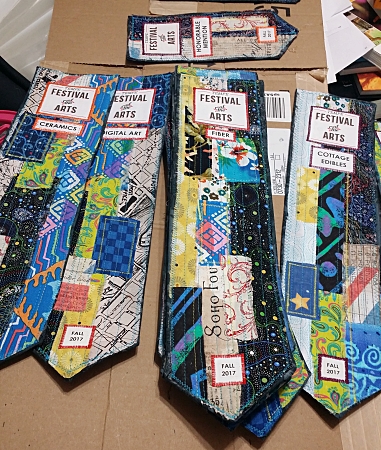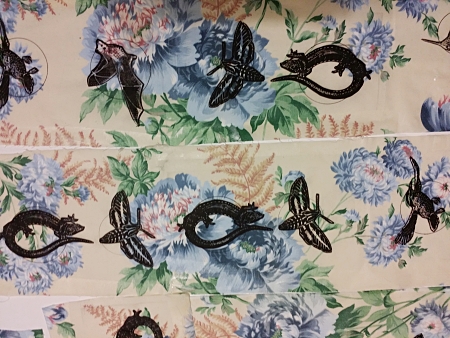I’m partway through the next set of award ribbons for the Tempe Festival of the Arts.
These are based on the work of Erin Curry, so for the applique backgrounds I used a mix of bright and subdued cotton prints glued on white felt pre-edged with dark green/blue rose print fabric. The prints have some unifying colors and thread patterns: deep blue starry effects, bright blue tropical prints, map and ledger fabric, touches of orange and yellow.
Then came sewing on the printed fabric show labels, three to a ribbon, for all seventeen main categories, the three ‘big’ awards, and two small honorable mention awards.

Curry’s ‘Animalia’ prints are tricky to adapt, even with my own photos and Painter 17. I really wanted to have the animal motifs sewn in black & white with an embroidery machine, but that’s not in the budget right now.
But wait…I had a few yards of pale pastel floral chintz. I have a laser printer. Ta da, gel transfers!

You can find clearer instructions online. Basically, work on a clean flat area. Have waxed paper or plastic-covered cardboard panels for drying. Paint a layer of clear acrylic gel medium all over the fabric area you want to cover, paint gel over the printed face of the fabric, press printed paper facedown into the fabric, and squeegee the hell out of the paper. This will force gel down into the fabric, and stick the paper image smoothly to the cloth.
Let dry on covered surface for between 3 and 24 hours, depending on how rushed and/or insane you are. Peel off the fabric from the drying platform. Dunk the fabric into a big tub of warm water. Do NOT use a bathtub for this unless you have a screen cap to prevent paper shreds from clogging your drain!
Let soak for a couple of hours. Peel off the paper, then gently rub off the rest of the paper fibers. The result: a gel layer trapping the laser printed image against the fabric. You can paint another layer of satin or matte gel over this, to make it stronger for wearable applications.
I’d forgotten how fun these can be and how clear an image they can yield. The trick apparently is fine-grained smooth natural-fiber cloth (cotton works best, in my experience). Linen will pick up the linen texture, which is great if you want that in your piece. An aged fresco effect can be achieved by sanding the face of the fabric lightly with 600-grit wet-dry sandpaper (but then you should paint a stabilizing gel layer over the top.)
Using a white-on-white print or a pale print fabric with strong transfer images gives depth to the prints. They can be embroidered and beaded over, and touched up with fabric paint.
Now that I remember how to do these, they’re going to be in some fiber art books.
What’s next for the award ribbons? Sew down the motif critters, then beadwork, then grosgrain ribbons and metal pin backs for ease of display.
Final pieces can be seen here.
I love the bats and moths and lizards on chintz. The juxtaposition of images reminded me of this new(ish) take on Willow Pattern crockery. Calamityware has been around for a few years now, and I covet the designs, but can’t hack the prices. Nice to look at on line though. See at: calamityware(dot)com(slash)collections(slash)plates